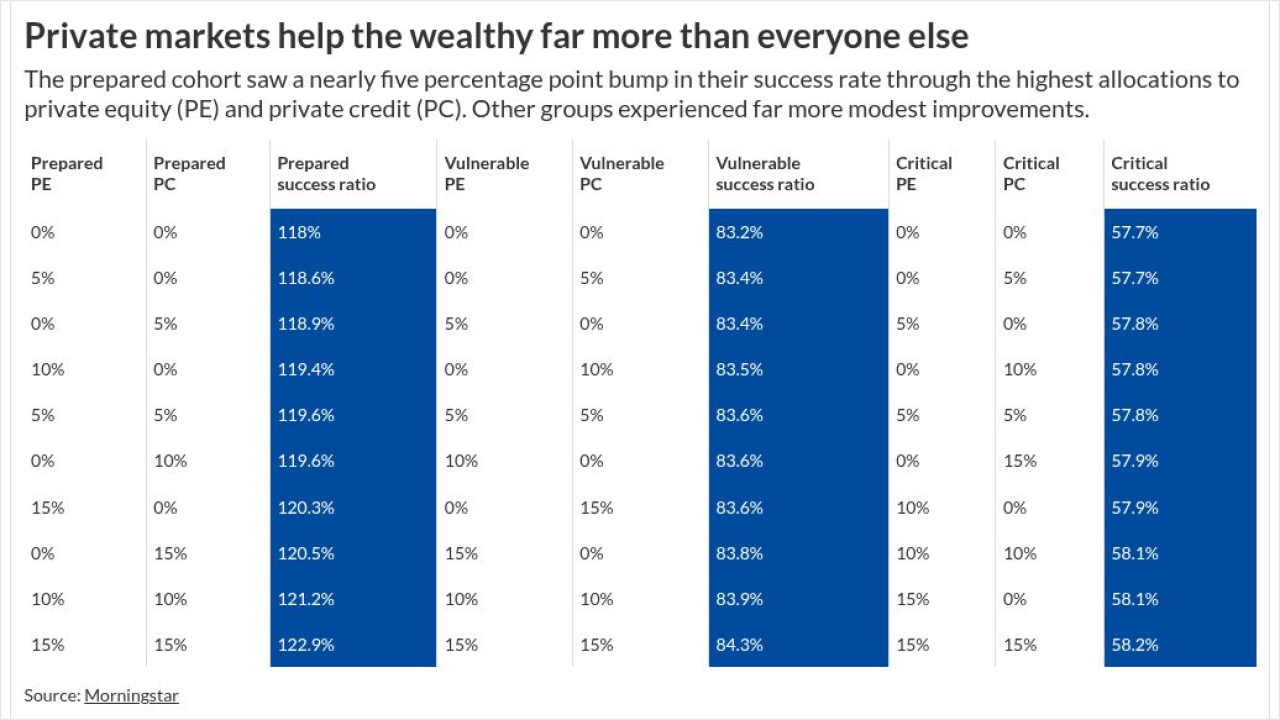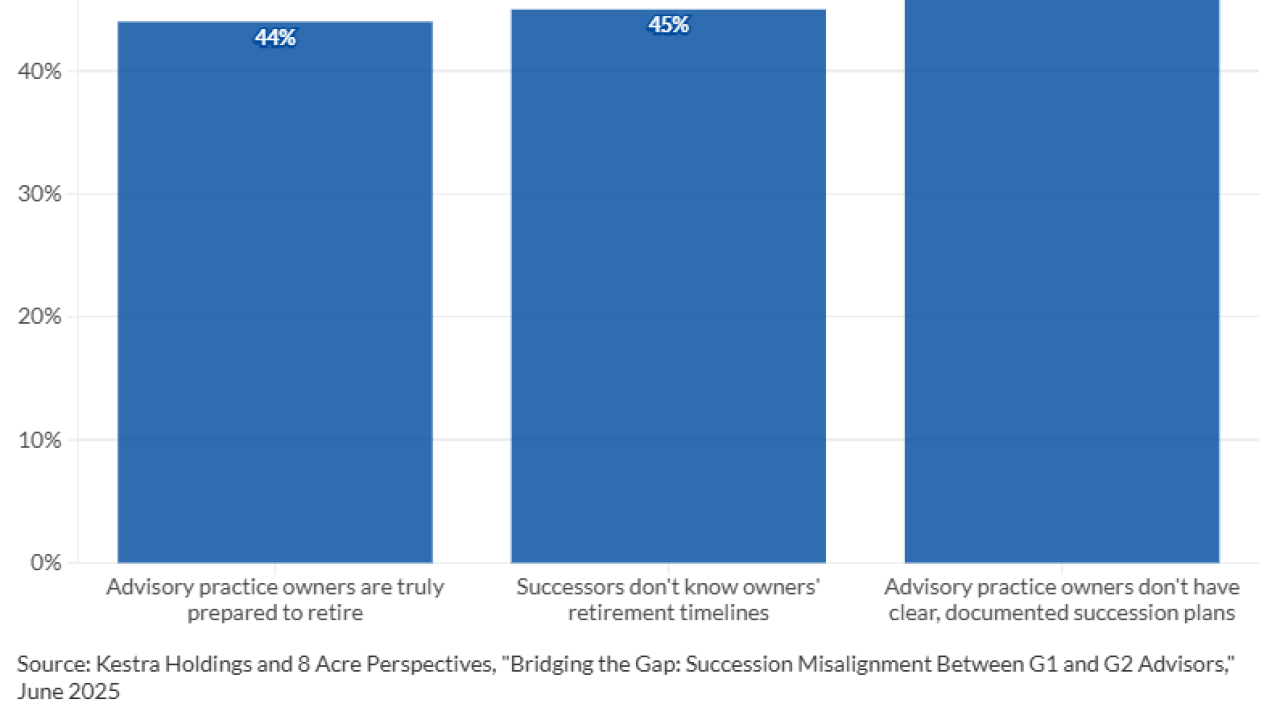The rising assets under management and annual revenue at RIAs may be hiding competitive threats related to talent and a lack of adoption of documented expansion strategies.
More than two-thirds of the 1,340 RIAs polled as part of data
However, firms with more than $250 million in AUM are raking in higher operating margins than smaller RIAs, investing more in their staff and finding the time and resources for strategic planning around succession, marketing, clients and value proposition. With record consolidation fueled by an onslaught of capital from private equity firms and other investors financing billion-dollar valuations, the big firms are rolling up more RIAs into their ranks every year. The question is whether smaller practices can keep up or if they even want to keep going it alone.
“There's room for all sorts of business models and goals and aspirations,” said Lisa Salvi, Schwab’s managing director of business consulting and education. “We can support those different goals and aspirations for those different businesses. And, if it changes for them in the future, there's a whole ecosystem out there.”
As the largest RIA custodian, Schwab works with 13,000 advisory firms managing $3.4 trillion in assets under custody. The firm spoke with more than 1,000 of the practices between January and March, unveiling data broken out by the size of RIAs this month after putting out the full
The findings
The data reveal how fast the advisory firms are extending their footprints, as well as the potential issues relating to talent and resources.
- Growth: The firms’ median AUM surged by 14.5% year-over-year to $439 million, on their way to an estimated $791 million by 2025. Their median revenue climbed 7.5% from a year earlier to $2.58 million, with a predicted $3.79 million by 2025.
- Profits: Firms of all sizes displayed healthy standardized operating operating margins in 2020, though firms with above $250 million in AUM came in at 29.8% compared to 26.0% at those below. Those with between $500 million and $750 million had the highest profit margin at 33.3%, followed by the 32.2% share at RIAs between $1 billion and $2.5 billion and 28.1% for practices with between $250 million and $500 million.
- Strategy: At a median among RIAs with at least $250 million in AUM, the firms that compiled marketing plans, ideal client profiles and statements of their value-added appeal brought in 50% more clients and 62% more client assets in 2020. Still, 41% of those firms haven’t created the client profile or value proposition, while 53% have no documented marketing plan. At smaller RIAs with less than $100 million, 75% have no marketing plan and 57% have no ideal client profile or value proposition. In addition, only 31% of those smaller firms have a written strategic plan.
- M&A and succession: Just 41% of RIAs with up to $100 million in client assets have written succession plans, in a contrast to 60% of firms with $250 million or above that have them and 71% of RIAs that Schwab calls “top performing firms” based on 15 different metrics. Despite the record consolidation, just 39% of RIAs with at least $1 billion in AUM say they’re actively seeking to buy another RIA. Only 14% of the smallest RIAs below $100 million are trying to buy another advisory practice, compared to 27% of firms with at least $250 million.
- Talent: More than three quarters of RIAs planned to hire staff this year, after 71% added a median of two new staff members in 2020. On the other hand, 59% of firms with at least $250 million in AUM lost a median of two staffers, 42% of top performers saw a median of two employees leave their firm and 25% of RIAs with under $250 million lost a median of one employee. In a sign of the challenge for smaller firms, the median spending for RIAs with more than $250 million in AUM for each professional’s training, education and dues was $1,711, compared to $1,250 for those below $250 million.
Two case studies
The complicated dynamics in the fragmented RIA industry are affecting all of the firms in the space. One of the largest fee-only RIAs, Los Angeles-based Abacus Wealth Partners, is making an interesting personnel change as firms
With its eyes on investing in its team, the firm hosted a half dozen summer staff members
“The great resignation is certainly on our minds. Neela and I talk about it all the time,” Storjohann said. “We actually started those over the summer, and they were so well-received that we kept them going.”
Since launching in 2004 through a merger of two practices, Abacus has reached a scale that Kessel says he never could have imagined at 70 advisors and employees with $4.4 billion in assets under management. At the beginning of the year, the firm acquired
“Our culture is extremely important for us,” Hummel said. “As we think about mergers and acquisitions, it's really important that we get values-aligned firms that work within our culture.”
Publicly traded RIA consolidator Focus Financial Partners has completed or announced 34 M&A deals this year, including 11 new partner RIAs and 23 tuck-in mergers,
“Only a fiduciary advisor can ultimately truly provide the quality advice that clients are looking for,” Adolf said. “One reason why there is no fee compression in this industry is because clients need this high-quality fiduciary advice. They value it, and they're willing to pay for it.”








